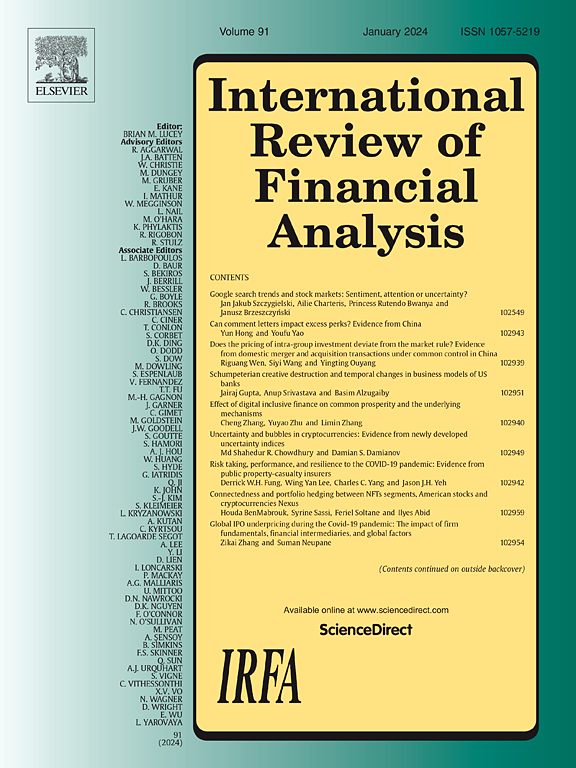Risk spillover effects of climate uncertainty on commodity markets: From the dual perspective of physical risk and transition risk
IF 7.5
1区 经济学
Q1 BUSINESS, FINANCE
引用次数: 0
Abstract
The issue of climate change is deeply intertwined with human activity and has a significant impact on human existence. To examine the spillover effects of climate change and climate policy on China's commodity market, this study adopts a dual-model approach, combining the time-varying parameter vector autoregressive (TVP-VAR) model and the dynamic conditional correlation generalized autoregressive conditional heteroskedasticity (DCC-GARCH) framework for empirical analysis. Impulse response graphs and dynamic conditional correlation coefficients, we analyze the spillover intensity of climate uncertainty and climate policy on the commodity market from both aggregate and pairwise perspectives via a spillover index. We find that the risk spillovers from climate uncertainty (CU) and climate policy uncertainty (CPU) to commodity markets are dynamic and time-varying, and three distinct peaks in climate uncertainty risk spillovers are identified during 2010–2012, 2016–2018, and 2021–2022. Compared with other industries, the energy and nonferrous sectors are more significantly affected by both physical and transition risks. Based on the TVP-VAR framework, physical climate risks are found to have a stronger spillover effect on China's commodity market. From the perspective of the CU index, the impact on the commodity market is generally negative, whereas the impact of the CPU index is generally positive. While, according to the DCC-GARCH framework, CPU dominates risk spillover, indicating that transition risks are substantially greater than physical risks. The CU index remains relatively stable and positively correlated with various industries, whereas the CPU index shows no such correlation.
气候不确定性对商品市场的风险溢出效应:基于实物风险和转型风险的双重视角
气候变化问题与人类活动密切相关,对人类生存产生重大影响。为考察气候变化和气候政策对中国商品市场的溢出效应,本研究采用双模型方法,结合时变参数向量自回归(TVP-VAR)模型和动态条件相关广义自回归条件异方差(DCC-GARCH)框架进行实证分析。在脉冲响应图和动态条件相关系数的基础上,通过一个溢出指数,从总量和两两角度分析了气候不确定性和气候政策对商品市场的溢出强度。研究发现,气候不确定性(CU)和气候政策不确定性(CPU)对商品市场的风险溢出是动态和时变的,气候不确定性风险溢出在2010-2012年、2016-2018年和2021-2022年出现了三个明显的峰值。与其他行业相比,能源和有色行业受实物风险和转型风险的影响更为显著。基于tpv - var框架,物理气候风险对中国商品市场具有更强的溢出效应。从CU指数来看,对商品市场的影响总体为负面,而CPU指数的影响总体为正面。然而,根据DCC-GARCH框架,CPU主导风险溢出,表明转型风险大大大于物理风险。CU指数与各行业保持相对稳定的正相关关系,而CPU指数则没有这种相关性。
本文章由计算机程序翻译,如有差异,请以英文原文为准。
求助全文
约1分钟内获得全文
求助全文
来源期刊

International Review of Financial Analysis
BUSINESS, FINANCE-
CiteScore
10.30
自引率
9.80%
发文量
366
期刊介绍:
The International Review of Financial Analysis (IRFA) is an impartial refereed journal designed to serve as a platform for high-quality financial research. It welcomes a diverse range of financial research topics and maintains an unbiased selection process. While not limited to U.S.-centric subjects, IRFA, as its title suggests, is open to valuable research contributions from around the world.
 求助内容:
求助内容: 应助结果提醒方式:
应助结果提醒方式:


